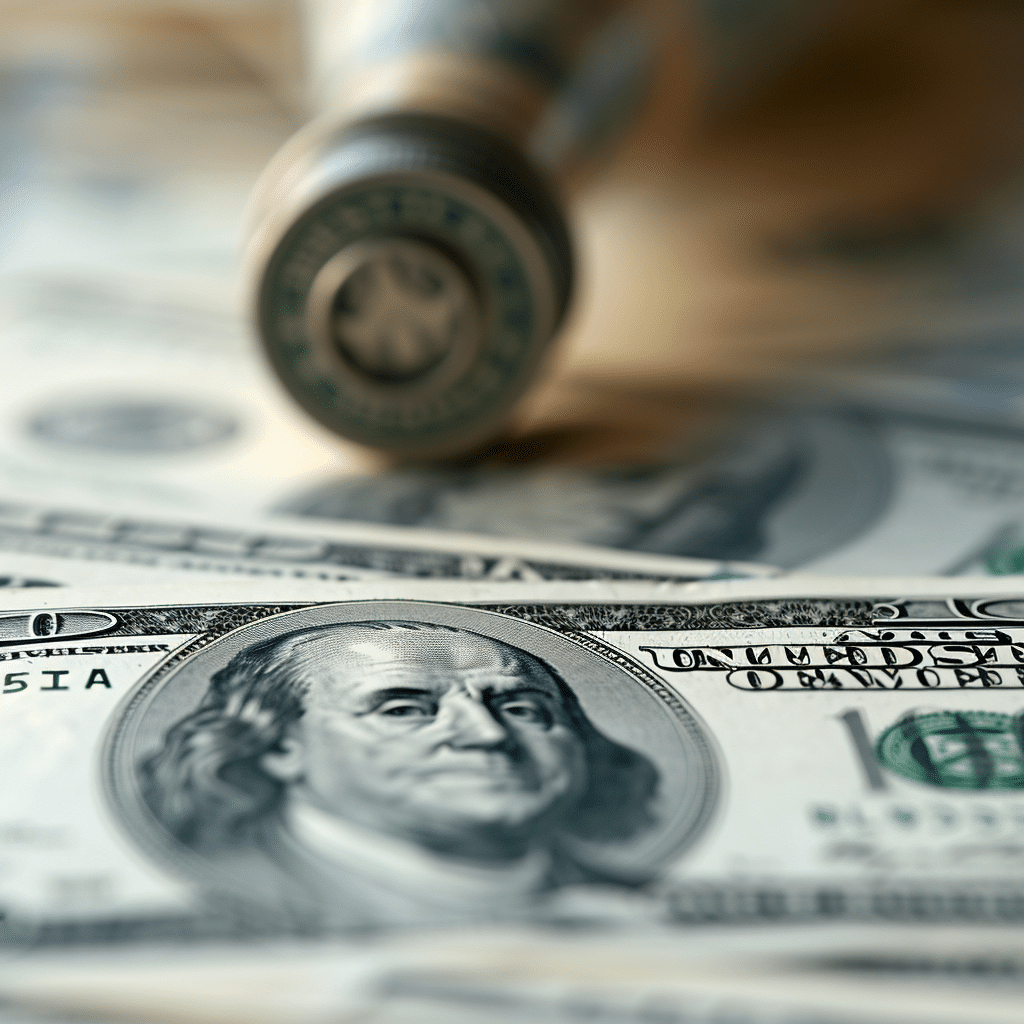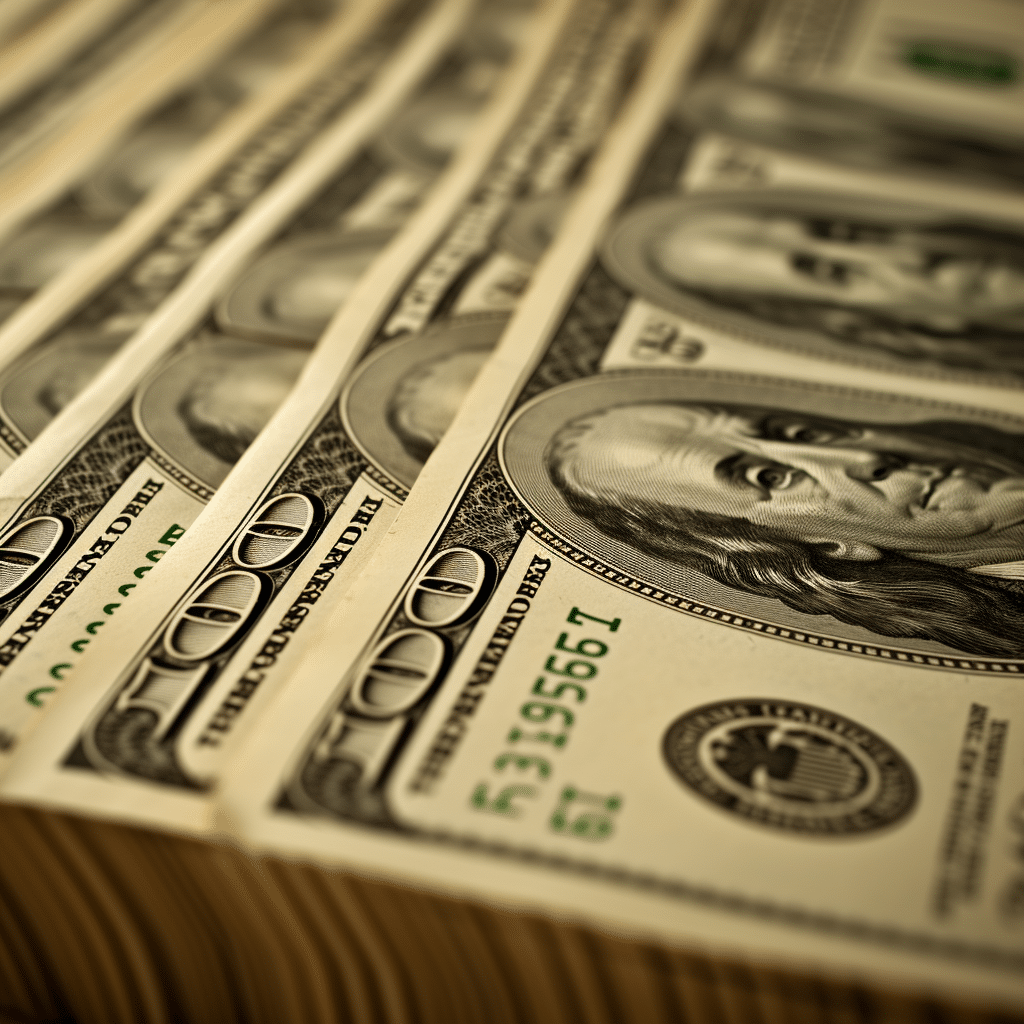Investing isn’t just about pouring money into the stock market and hoping for the best; it involves a pinch of wisdom, a dollop of strategy, and, let’s not kid ourselves, a generous serving of staying updated with economic indicators like treasury bills interest rates. It’s important for savvy investors and mortgage fans alike to stay informed about the latest movements in the financial world, and treasury securities are a significant part of this universe.

The Impact of 1 Year T-Bill Rates on Your Investments
How 1 Year T-Bill Rates Reflect Economic Trends
Want a crystal ball for economic forecasting? Well, you might just find the next best thing in the 1 year T-bill. These nifty little financial instruments are like barometers of the economic climate. The 2024 outlook suggests a pinch of volatility, with the 1 year Treasury Rate sitting at a higher-than-average 4.87%, a hop up from 4.81% just the day before, and marking a bump from 4.79% the prior year. Treasury bills interest rates aren’t just numbers—they’re stories, telling us about investors’ confidence, the state of the economy, and what might be around the corner.
Comparing Short-Term Interest Rate Patterns to Larger Economic Indicators
Why does this matter to you? Let me lay it out plain and simple. Spikes in the 1 year T-bill can signal inflation rising faster than a hot-air balloon. On the flip side, dips might mean the economy’s taking a snooze. Either way, it’s essential to adjust your portfolio accordingly to keep your investments from sinking like a stone.
Providing Investor Insights and What This Means for Portfolio Adjustments
What’s a surefire way to stay as cool as a cucumber with your investments? Keep a keen eye on these treasury bills interest rates and stay nimble. Pros might tell you to zig when others zag—dialing up the T-bills when rates and economic uncertainty are on the rise, or zigging towards more growth-oriented options when rates trend lower and stability seems to be the day’s soup du jour.

The Landscape of Interest Rates on Treasury Bills in the Current Fiscal Year
Trends in Treasury Bills Interest Rates and What They Signal
Let’s talk shop about the current lay of the land, shall we? We’ve seen the 3 Month Treasury Bill Rate flex its muscles up to a sturdy 5.23%, a smidge higher than the day before’s 5.22% and quite the leap from last year’s 4.53%. Why should you care? Because these rates are more than just idle chit-chat—they tell a story about what’s cooking in the economy’s kitchen.
Examining the Federal Reserve’s Rate Decisions and the Implications for T-Bill Rates
Ah, the good ol’ Fed, the grandmaster of rate chess. The Federal Reserve sometimes moves its pawns, the interest rates, making your next investment move as critical as a queen’s gambit. If the Fed hikes rates, it can give T-bill rates a kick upwards like a caffeine jolt in the morning.
Understanding the Correlation Between T-Bill Rates, Inflation, and Monetary Policy
T-bill rates and inflation are like an old married couple; where you find one, the other’s usually close by. Higher interest rates on treasury bills can be a symptom of inflation’s fever, as the Fed adjusts the thermostat of our economy with monetary policy to get things just right.

| Item | 3-Month T-Bill | 1-Year T-Bill |
| Current Rate | 5.23% | 4.87% |
| Previous Day Rate | 5.22% | 4.81% |
| Rate One Year Ago | 4.53% | 4.79% |
| Long-Term Average Rate | 4.19% | 2.93% |
| Maturity | 3 months | 1 year |
| Security Type | Short-term US government debt security | US government debt security |
| Issuer | U.S. Department of the Treasury | U.S. Department of the Treasury |
| Credit Quality | Highest (backed by full faith and credit of U.S. government) | Highest (backed by full faith and credit of U.S. government) |
| Interest Payment | Discounted (sold at less than par value and mature at par value; the difference is the interest earned) | Discounted (sold at less than par value and mature at par value; the difference is the interest earned) |
| Pros | – Very low credit risk | – Very low credit risk |
| – High liquidity | – Relatively high liquidity | |
| – Suitable for short-term investment goals | – Fixed rate of return can provide stable income over 1 year | |
| Cons | – Lower yields compared to other investments in a high interest rate environment | – Yields can be lower than longer-term investments, especially during periods of rising interest rates |
| – May underperform in an inflationary environment | – Locked-in rate could underperform if rates increase sharply after purchase |
Treasury Bills Interest Rates vs. Traditional Savings: Assessing Your Options
Comparing Treasury Bills Interest Rates to Savings Account Yields
It’s the old “savings account versus T-bills” debate—classic as vanilla versus chocolate. And let me tell you, in today’s financial diet, the creamy interest of treasury bills interest rates might be the flavor of choice for some over that plain old savings account taste.
Discussing Liquidity Considerations, Risk Assessment, and Returns on Investment
Just as a master chef knows the importance of balancing spices, investors need to balance liquidity and risk to cook up the tastiest returns. T-bills might be the investment equivalent of a slow-cooked stew, offering stability with just a hint of zest from their fixed rate of interest.
Presenting Expert Financial Advice on Diversifying with T-bills
So you’ve got your financial ingredients lined up—how about adding some T-bills for that extra crunch? Experts in the kitchen of wealth-building recommend a diversified portfolio, just as a well-rounded meal pleases the palate.

Unlocking the Relationship Between Treasury Bills and Treasury Bonds Interest Rates
Treasury Bonds Interest Rates as a Long-Term Indicator Next to Short-Term T-Bills
For those of you with a fondness for the long haul, treasury bonds interest rates might just be your future teller. These are the marathon runners of the investment race, their trend lines scratching out predictions across the financial horizon.
Dissecting the Differences in Movement Between Short-Term T-Bill and Long-Term Treasury Bond Interest Rates
It’s one thing to sprint; it’s another to run a marathon. T-bills are your sprinters; quick, reactive. Treasury bonds are in it for the long distance, gradually shifting as the economic landscape changes.
Case Studies: How Major Investment Firms Are Leveraging This Information
Major investment firms are the grandmasters in the financial game, often making moves based on the nuanced relationship between treasury bills interest rates and treasury bonds interest rates.
Forecasting Market Trends Based on the Yield Curve, and What This Means for Individual Investors
The yield curve—it’s like a weather map for your assets. When it’s sloping up, strap on your hiking boots; prosperity might be on the path ahead. But if that slope starts slipping, it could be time to bunker down for an economic cold snap.

The Global Perspective: How International Events Influence Treasury Bills Interest Rates
International Events that Shocked Treasury Bills Interest Rates
When the world sneezes, treasury bills interest rates can catch a cold. Global events—from geopolitical standoffs to trade tiffs—can send shockwaves that make T-bill rates twitch faster than a cat’s whiskers at a sound.
Real-Time International Market Analysis, Featuring Expert Commentary
Want the lowdown on the global market’s impact on T-bills? Just like tuning into a weather channel, expert analysis on this topic serves up real-time forecasts that can shape your investment strategy.
Strategies for Mitigating Risks Posed by International Economic Shifts in Your T-Bill Investments
As the financial world turns, keeping your investments from getting dizzy with it all might mean employing some savvy risk mitigation strategies.
Conclusion: Synthesizing Treasury Bills Facts for Financial Growth
Well, that was quite the excursion through the land of treasury securities, wasn’t it? From the up-and-coming landscape of treasury bills interest rates to the global gusts affecting them, it’s a rich tapestry of factors that can influence our fiscal futures.
Today’s financial savants know that keeping an eye on the 1 year T-bill and treasury bonds interest rates can be as crucial to investment strategy as a chess player’s focus on the king. Why? Because much like a king, they can influence the moves and outcomes on the broader economic chessboard.
Investors, consider yourselves armed with a trove of insights. Now the ball—or rather the bill—is in your court. Navigate the landscape of T-bill rates with the foresight of an owl, and you just might find yourself swooping down on the riches of savvy investment practices.
Ready for the next steps? As you ponder your portfolio, remember the currents of treasury bills interest rates have tales to tell. Whether it’s rising 1 year T-bill rates or the steady ship of longer-term T-bonds, a finger on the pulse of these rates helps keep your investments healthy and your financial garden flourishing.
So, go forth and let your investments bloom brighter than springtime in the Rockies, and may your financial journey be as smooth as the finest velvet. Stay wise, stay informed, and keep your sails adjusted to the breezy whispers of the treasury markets.
Surprising Tidbits About Treasury Bills Interest Rates
Treasury bills, often called T-bills, are the skinny jeans of the investment world; they’re a classic staple in a financially savvy person’s wardrobe. These short-term government securities are as reliable as the reputation of Mary Wickes in Hollywood—rock solid and dependable. And just like Mary’s legacy, the intrigue behind T-bills has a few plot twists that might just raise your eyebrows. Here are some stunning facts about Treasury bills interest rates that will have you hooked!
The Chameleon Nature of T-Bill Rates
Did you know that Treasury bills interest rates can flip-flop faster than fashion trends for skinny Women? One day they might be strutting confidently down Wall Street, and the next, they’re retreating faster than a shy cat at a dog park! T-bill rates are determined by supply and demand in the market—just like concert tickets or those limited-edition sneakers everyone seems to want. Better keep a close eye on the five year treasury rate to stay in the loop!
The Art of Predicting Interest Rates
Predicting T-bill interest rates can be as tricky as predicting the next twist on your favorite Bounce TV schedule. Many investors fancy themselves as seers, but in reality, predicting where rates will go is like trying to nail jelly to a wall—messy and nearly impossible! Don’t worry, though; you’re not alone in this game of financial fortune-telling.
The Secret Savers: I Bonds
Here’s an insider tip that might surprise you—when Treasury bills interest rates are more up and down than a yo-yo, current i Bonds rates can offer a smoother ride. Similar to comfort food, I bonds provide a stable and predictable return, which can be particularly cozy during erratic economic climates. Having a mix of T-bills and I bonds in your investment portfolio is like having a wardrobe that’s ready for any season!
The DMV of Investments
Purchasing Treasury bills can sometimes feel as tedious as waiting in line at the Roseville Dmv. It’s not exactly the thrill of a lifetime, but it’s a necessary process to get where you want to go—financial security. Hold tight, remember your paperwork, and keep an eye on the prize; your patience will pay off in the long run, even if it feels like you’re stuck in the slow lane.
The “No Risk, No Reward” Myth
You might think that higher risks always lead to higher rewards, akin to performing blow Jobs With Swallowing in the investment world. However, T-bills blow that theory out of the water. They’re much like the designated driver in your squad—low risk and reliable. But here’s the kicker: even though they’re considered a safer investment, they often provide a decent return for the risk-averse crowd. Who knew playing it safe could still be so rewarding?
The Pulse of the Economy
Treasury bills interest rates are like the heartbeat of the economy—they give an insight into the country’s financial health without requiring a PhD. in economics. A spike in rates could mean the economy is on a caffeine high, ready to take on the world. A drop, on the other hand, might signal that it’s time for a nap—a big, fat economic siesta.
So there you have it, folks! Diving into the world of Treasury bills interest rates can be as entertaining as it is enlightening! Who would’ve thought that something as seemingly bland as government securities could hold such fascinating secrets? Keep these mind-boggling facts in your back pocket, and you’ll be the life of the party—or at least the financial whiz at the next family barbecue!

What is the interest rate on Treasury bills today?
– Talk about a tiny uptick! The 3 Month Treasury Bill Rate today is sitting pretty at 5.23%, just a hair’s breadth above yesterday’s 5.22%. It’s also left last year’s rate of 4.53% in the dust. A steady climb past the long term average of 4.19%, don’t you think?
How much do 1 year Treasury bills pay?
– One-year T-bills? They’re dishing out a yield of 4.87% as of today. That’s a slight nudge up from 4.81% yesterday and inching above last year’s 4.79%. With a long-term average of just 2.93%, this feels like a bit of a roller coaster, doesn’t it?
What is the Fed 6 month T bill rate?
– Oh, hold your horses! While we’ve got the scoop on the 3 Month Treasury Bill Rate at 5.23%, the Fed hasn’t spilled the beans on the 6 Month T-bill rate just yet. You’ve gotta keep an eye on financial news for that fresh out of the oven rate.
Are Treasury bills a good investment now?
– Are T-bills the cat’s pajamas investment-wise? Well, they’re safer than a bunker in tough times! But here’s the kicker: they offer a fixed interest, which is great for stability, but the trade-off is you might miss out on higher returns elsewhere. Depends on how you play the game!
How much does a $1000 T bill cost?
– A $1000 T-bill cost? Ah, it’s a bit like a guessing game because you’ll nab it at a discount to face value. But the exact number? It hinges on the current rates and the going auction results. Hang tight and watch those auctions like a hawk.
Are Treasury bills better than CDs?
– It’s a classic showdown: T-bills versus CDs. T-bills are government-backed—pretty much as solid as a rock. But CDs can sometimes offer higher interest, especially with rising rates. So, it’s about playing your cards right and seeing what suits your financial outfit!
What happens when T-bill matures?
– When a T-bill matures, you’re in the money – literally! You cash in on the full face value. Think of it like a bottle of wine that’s finally ready to be uncorked—it’s time to enjoy the fruits of your patience.
Are Treasury bills tax free?
– Tax-free? Hah, if only! While the IRS won’t touch the state and local taxes on T-bill interest, Uncle Sam’s hand will still be out for those federal taxes. So, better save a slice of that pie for tax time.
How much will I make on a 4 week Treasury bill?
– Earning on a 4 week T-bill? You’re playing the short game here, so your earnings will be modest. It’s based on current rates, and you’ll get the exact figures once that T-bill is in your pocket and matures.
What is the yield on a 52 week Treasury bill?
– The yield on a 52-week Treasury bill is like a sneak peek into a crystal ball – it changes with each auction. Given today’s economic tune, it’s likely higher than what your grandpa got back in the day, but for an exact note, you’ve got to watch the latest auction results.
How much Treasury bills can I buy?
– How much T-bill can you bag? The sky’s the limit—well, sort of. You can go from as little as $100 to as much as your bank account can handle. Just be sure you’re not putting all your eggs in one basket!
How do I buy a T bill?
– Want to grab a T-bill of your own? Roll up your sleeves and head over to TreasuryDirect or hit up a broker. It’s like shopping online—quick, easy, but make sure to read the fine print!
Does Warren Buffett buy Treasury bills?
– Does Warren Buffett stockpile T-bills? You betcha! He’s known to keep a chunk of his war chest in T-bills, ready to pounce on opportunities. It’s like keeping a good bottle of champagne on ice, just waiting for the right moment to pop it!
Why am I losing money on Treasury bills?
– Losing money on T-bills? Sounds like a bad dream! Usually, this happens when interest rates do the limbo and go even lower after you’ve bought your T-bill. Or maybe inflation’s eating into your returns. Keep a cool head—it’s all part of the investment tango.
Why not to buy Treasury bills?
– Why take a pass on T-bills? If you’re chasing after high-flying returns, T-bills might seem like they’re moving in slow-mo. With their safety comes lower yields, especially in a low-rate environment, so weigh your options, Maverick!
How much will I make on a 4 week Treasury bill?
– How much will you rake in on a 4-week T-bill? It’s like trying to guess the winning lottery number before the draw. You’ll have to keep tabs on the current rates and auction results to strike it rich with the exact figures.
What is a 3 month T-bill?
– What’s a 3-month T-bill? Picture this: it’s a short-term government IOU that matures quicker than you can say “interest rates,” specifically in three months. It’s like a sprinter in the world of investments.
Do you pay taxes on treasury bills?
– When it comes to treasury bills and taxes, yeah, you’ve gotta pony up to Uncle Sam for federal taxes. But it’s not all gloomy—you’re off the hook for state and local taxes, so it’s a bit of a tax break at least.
Is the 3 month T-bill rate annualized?
– Is the 3 month T-bill rate a yearly thing? Sure is! They call it annualized, which means the rate is a projection of what you’d earn if you kept rolling over the bill every three months over a year. It’s like getting a sneak peek at your yearly earnings!



